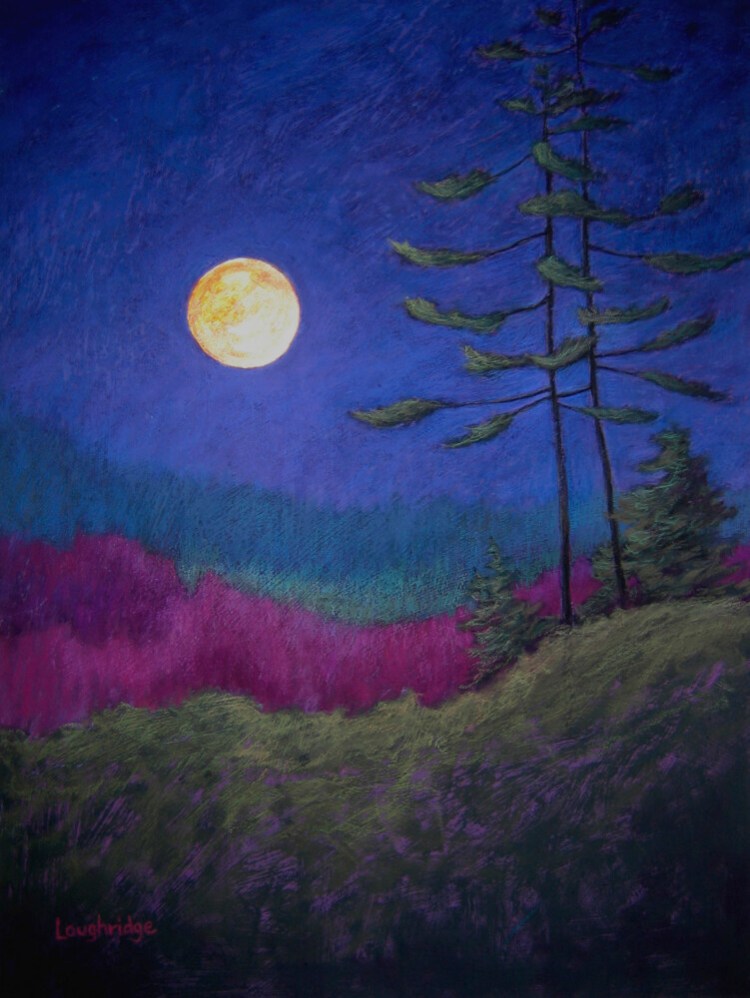When Marnie Sinclair moved to Maine from Martha’s Vineyard, the shift from the effeminate quality of the sandy Cape islands to the rugged masculinity of Maine’s granite coast reminded her what it felt like to live in Alaska.
“You really have to work to fit in,” said Sinclair, an artist now living in Damariscotta. “Mother Nature is in charge around here.”
Sally Loughridge Busch, a painter from South Bristol, reveres the habitat around her home, both its hard edges and soft underbellies. “I don’t paint people or buildings – boats occasionally, but it’s really about Maine as a natural habitat. I am drawn to it, with reverence.”

“Lake Core” by Jill Pelto, part of series of watercolors using scientific data to illustrate climate change. Maine Coastal Islands National Wildlife Refuge
Jill Pelto, an artist and scientist who lives in the Portland area, uses data generated by research to guide her cautionary watercolors that document warming waters and shrinking glaciers. Pelto spent her young years tagging along with her glaciologist father while he studied the impact of climate change. “It was not inspirational at all. It was more the opposite,” said Pelto. “It was hard to witness.”
The artists are showing together in concurrent exhibitions at the Maine Coastal Island National Wildlife Refuge in Rockland, on view through Oct. 28.
Pelto is showing her data-driven paintings in a solo exhibition, “Data Reflections.” At the University of Maine, she studied studio art and earth science as an undergraduate and earned a master’s of science studying the sensitivity of the Antarctic ice sheet because of changes in the climate. During that time, she began using research data to make art.
“I was used to reading graphs. They communicated to me a clear story of change over time. But for a lot of people, they did not. So I thought pairing data with art was a great way to convey the information,” she said.

Marnie Sinclair pairs her wire rooster sculpture with a soft pastel by Sally Loughridge Busch in their group exhibition “Home Place.” Maine Coastal Islands National Wildlife Refuge
Sinclair and Busch pair their work in a show they are calling “Home Place.” Sinclair is showing a range of wire sculptures of Maine animals inside the gallery, and a range of sculptures made with trash and plastic on the grounds outside the visitor center. Busch is showing an array of oil paintings and pastels that present the glory of her habitat in all seasons and colors.
Carney McRae, outreach coordinator for the Friends of Maine Coastal Islands National Wildlife Refuge, said the art gallery serves an important role in reminding visitors of the fragile and changing nature of the Maine coast. The refuge spans 250 miles and includes more than 70 offshore islands and four coastal parcels, she said. The art gallery inside the Rockland visitor center features Maine artists who are most familiar with the environment. It’s a natural fit in Rockland, which likes to call itself the art capital of Maine, McRae said.
“The art gallery helps tell the story of our environment and nature through the visual arts, and it inspires people to take action as needed,” she said. “It’s another way to connect people to this refuge and the environment, the conversations that are happening around it, and the need to take care and action to protect it.”
Send questions/comments to the editors.




Success. Please wait for the page to reload. If the page does not reload within 5 seconds, please refresh the page.
Enter your email and password to access comments.
Hi, to comment on stories you must . This profile is in addition to your subscription and website login.
Already have a commenting profile? .
Invalid username/password.
Please check your email to confirm and complete your registration.
Only subscribers are eligible to post comments. Please subscribe or login first for digital access. Here’s why.
Use the form below to reset your password. When you've submitted your account email, we will send an email with a reset code.